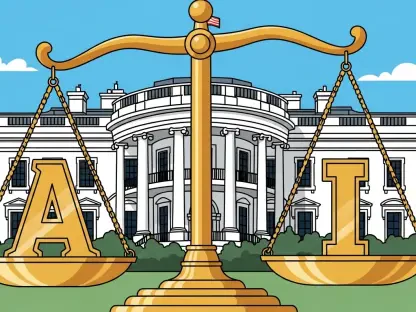Welcome to an insightful conversation with Desiree Sainthrope, a distinguished legal expert with a wealth of experience in drafting and analyzing trade agreements. With her deep expertise in global compliance and intellectual property (IP), particularly within the defense sector, Desiree offers a unique perspective on the evolving IP frameworks of the US Department of Defense (DOD) and the UK Ministry of Defence (MOD). Today, we’ll explore how the shift to software-driven defense technologies is reshaping IP policies, the challenges companies face under traditional rules, and the innovative approaches being adopted to balance government needs with industry innovation. Let’s dive into this critical topic that impacts national security and technological advancement.
Can you walk us through why intellectual property has become such a pivotal issue for defense tech companies in recent years?
Absolutely. The defense sector has undergone a dramatic transformation, moving from a hardware-centric focus to a software-defined paradigm. This shift, driven by emerging technologies like AI, autonomous systems, and quantum computing, means that the real value and innovation now lie in software rather than physical components. Software is what powers the capabilities of modern defense systems, making IP protection critical for companies. Their proprietary algorithms and data systems are often the result of significant private investment, and losing control over that IP can jeopardize their competitive edge not just in defense, but in commercial markets too. Additionally, conflicts like the one in Ukraine have shown how low-cost, software-driven solutions can outperform traditional hardware, further elevating the stakes for IP as a strategic asset.
How has the transition from hardware to software in defense systems changed the way companies approach IP protection?
The transition has fundamentally altered the landscape. In the hardware era, IP was often tied to tangible designs and manufacturing processes, which were easier to delineate and protect under government contracts. Software, however, is more fluid—it’s iterative, often built on pre-existing code, and can be easily shared or modified. This makes it harder to define ownership and control. Companies now have to be much more vigilant about safeguarding their background IP while working on government-funded projects. They’re also grappling with the fact that software updates and maintenance blur the lines between initial development and ongoing support, creating new IP vulnerabilities that didn’t exist with hardware.
What are some of the biggest hurdles defense tech companies face when dealing with traditional IP policies from agencies like the DOD or MOD?
Traditional IP policies were designed for a time when hardware dominated and projects were mostly government-funded on cost-plus contracts. These rules often grant the government broad rights, like ‘Unlimited Rights’ or ‘Government Purpose Rights’ in the US, to use, modify, or share a company’s technology. This clashes with the needs of software-driven firms who rely on proprietary tech as their core asset. For instance, a commercial tech company might hesitate to adapt its cutting-edge AI for military use if it means the government can share that tech with competitors. These outdated frameworks can deter innovation by making companies feel they’re risking too much for too little return, especially on smaller initial contracts.
Could you share an example of how these traditional IP rules might discourage a commercial tech firm from entering the defense market?
Certainly. Imagine a startup that’s developed a groundbreaking AI algorithm for autonomous systems. They’re approached by the DOD for a small prototype contract, but the terms require them to grant ‘Government Purpose Rights,’ meaning the government can use or disclose their tech for any government purpose, potentially even to competitors after a few years. For a small firm, that’s a huge risk—their entire business model might depend on exclusivity. So, they might walk away, even if the contract could be a foot in the door, because the potential loss of control over their IP outweighs the short-term gain. This is a real barrier to bringing commercial innovation into defense.
How have recent updates in DOD policies, such as those from the 2018 National Defense Authorization Act, started to address these challenges for companies?
The 2018 NDAA marked a turning point for the DOD by pushing for a more balanced approach to IP rights. It introduced the idea of ‘specially negotiated’ licenses, which consider the funding sources and investments of both parties—government and contractor. Instead of automatically claiming broad rights, the DOD is now encouraged to acquire only the minimum rights needed for its mission. This is a big win for companies, especially smaller ones or startups, as it allows them to retain more control over their proprietary tech while still collaborating with the government. It also fosters an environment where private investment in innovation is less discouraged, paving the way for more commercial tech to enter the defense space.
Turning to the UK, how does the MOD’s approach to IP, particularly through terms like DEFCON 91 and DEFCON 707, impact companies working on defense projects?
The MOD’s approach, embodied in DEFCON 91 for software and DEFCON 707 for technical data, mirrors some of the traditional challenges seen in the US but with its own flavor. DEFCON 91, for instance, grants the MOD rights similar to ‘Government Purpose Rights’ over software deliverables, even including pre-existing proprietary code unless flagged early for additional compensation. This can be a deterrent for commercial software vendors who don’t want their core IP exposed. DEFCON 707, while offering clearer protections for background IP compared to older rules, still leans toward broad government access for future procurement needs. Both sets of terms can make companies wary, as they feel they’re giving up significant control without guaranteed long-term benefits.
With the launch of UK Defence Innovation in July 2025, what potential do you see for transforming IP management in UK defense projects?
The establishment of UK Defence Innovation, or UKDI, is promising as it aims to streamline the innovation ecosystem within the MOD. By consolidating various innovation units under one umbrella, it could create a more coherent and flexible IP strategy across different stages of projects—from early research to full-scale development. The potential lies in UKDI’s commitment to alternative contracting methods and recognizing that innovation often involves higher-risk, early-stage tech where traditional IP rules don’t fit. If implemented well, this could mean more tailored IP agreements that attract commercial players by better protecting their interests. However, it’s early days, and the success will depend on how these promises translate into actionable, industry-friendly policies.
Looking ahead, what is your forecast for the future of IP policies in defense contracting over the next decade?
I’m cautiously optimistic. Both the DOD and MOD have recognized that clinging to outdated IP frameworks stifles the innovation they desperately need to maintain military superiority. Over the next decade, I expect we’ll see even more nuanced and flexible policies, with a stronger emphasis on custom licensing that reflects the unique contributions of contractors, especially in software and AI. There will likely be a push toward dual-use technology frameworks, allowing companies to commercialize their innovations outside defense while meeting government needs. However, the challenge will be balancing national security with industry incentives—governments won’t fully relinquish control, so ongoing dialogue and trust-building between agencies and companies will be crucial to shaping a sustainable IP landscape.









